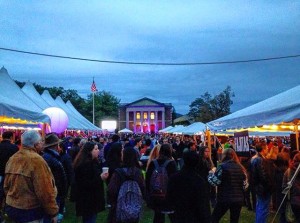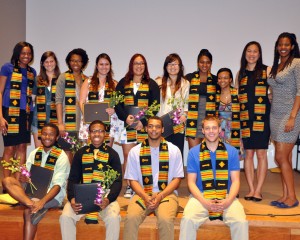Methods Exercise 3
Performance Studies: Dramatizing Texts and Reading the Performed Body
–Performative Writing–
“Campaign Launch” – October 3, 2015 (6:00pm – 6:45pm)
As I step out from the music building, the cold air hits me immediately and I look down at my bare legs, suddenly regretting my decision to wear a dress tonight. “We were thinking of dressing nicely,” Claire had said yesterday, right after my choir and I had decided on wearing jeans and Williams gear. I am going to be on the big stage tonight, along with Claire and four other students, leading the audience in “The Mountains.” We are only supposed to be up there for 5 minutes so I didn’t really see the point of getting all dressed up, but “Sure,” I had answered Claire. It was, after all, going to be a performance.
Walking up the stairs towards Paresky Lawn, I look around and see only 200 or so people milling about. The event covers all of Paresky lawn as well as the new library quad. Over the past couple of weeks, workers had toiled tirelessly to grow grass on the new field, but a few days ago they began covering the beautiful new growth with thin slabs of wood and then with sheets of fake plastic grass. It is greener, cleaner and sturdier than the real grass for sure, but it doesn’t help the over-all feel of Williams “trying too hard” to put on this show. And it is a show. At the very end of the fake lawn, right before you hit the new marble ground in front of Stetson Sawyer, there is a massive black stage set up. This is the one I’ll be standing on later. It’s the kind of thing you see at music festivals, with lights, microphones, a near-by sound tent, enormous speakers on either side, three huge screens (currently displaying the name “Williams” in our classic font) and a full crew comprised of both professional technicians and students. By the looks of it, you’d think some big production was about to take place…
Indeed, the super-secret surprise performer is all anyone has been talking about for a week, and having the stage right in front of us is definitely cranking up the anticipation.
“I saw a limo pull up earlier, maybe they did get Kanye…” someone laughs.
“I heard it’s supposed to be the Dave Mathews Band,” his friend offers.
“No, isn’t it that Chinese musician guy, the one that was an alumn?”
“I thought they asked him and he said no? Or he got sick or something…”
“I don’t know…guess we’ll find out…”
It’s fifteen minutes into the event and as more people show up, the energy is exciting but not exactly celebratory. People are happy enough to be here getting free food, hanging out with friends, etc., but there’s this kind of awkwardness in the air. No one really gets why they’re here, why it’s such a big deal, or even how big of a deal it is. A campaign launch for newer buildings (this is what people are assuming the money is for because we don’t know that either) is great and all, yay for the college, but the way they’re hyping it all up, keeping all these secrets…the stage…the fake grass. People are confused. I know I am. I’m actually performing on that stage and I still have no idea what’s going on.
I look away from the tent and survey the rest of the area. There are at least 10 white tents set up; most are on Paresky Lawn, with only three on the new quad. One huge one has rows and rows of tables and chairs. The rest are small, some offering food and snacks, others offering beverages, both hot and cold, and some acting as “stages,” where some of the student performers are showcasing their talents. The food tents have white signs with blocky purple writing advertising their selections: “Chicken Tikka Masala,” “BBQ Beef & Pad Thai,” “Chili, Fajitas,” “Apple Treats,” and my favorite one so far, “Popcorn, Cotton Candy, & Sausages.” A little bit of everything, it seems.
At the sight of food and the sound of music, my choir is starting to disperse so I shout out some reminders about meeting at Chapin steps, or “Stage 1,” in an hour. This is where they have arranged for Gospel Choir to perform. Some of us go off in twos or threes but the majority of us stay in the “Chicken Tikki Masala” line. We’re in good spirits, having just completed an almost perfect run through of the songs we’ll be singing tonight. Most of us are still humming or singing together, harmonies flowing in and out, when a lady with a giant camera suddenly comes up to us. “Can I get a picture of you guys?” she asks. The choir is excited. We round up our members and huddle together, smiling brightly. This is our first pic of the semester with all our new members. Being with our little family, it feels good. The smiles feel real, natural.
“It’ll probably show up on the screens in a few minutes” she informs us. We all “ooh” and “ahh” at this and every pair of eyes scans the area for the screens. I glance at my choir and realize how diverse we are: a mix Black, White, Latina, Asian people singing gospel music. A little bit of everything. I can’t help but think how we’re exactly what Williams wants up on that screen. Suddenly, the picture feels staged, like those pictures on the brochures colleges send out to convince prospective students that there’s diversity on campus.
As I reach the front of the line, I’m given a small brown carton with a spoon of rice, a ladle of chicken masala sauce, a veggie fritter and a fork. The lady asks to see my wristband, the one that confirms I’m a student at Williams and should be getting free food and drink. Really, I wonder, what else would a black girl be doing in this place? Soon, she’s not going to have time for this, I realize, as I walk away. The line behind me is already fifty people deep. My friends and I wander to the acapella tent, or “Stage 4,” where a sizable crowd is listening to the Ephlats performing a rendition of Madonna’s “Like a Prayer.” Everyone is jamming and cheering them on. For a moment it just feels like an outdoor Ephlats concert, which is totally plausible on this acapella-obsessed campus. This, right here, is authentically Williams but the event stretches yards beyond this little pocket of people.
I’ve somehow blocked out all the different musical performances up until now. Back on Chapin steps, Comboza is entertaining a crowd with their improvisational comedy. Bursts of laughter suggest they’re doing a good job. Right next to them, projected onto a huge screen, is the emerging artwork of a student sketch artist. On Paresky steps, a student band is providing perfect background music for all the diners, and off towards Main Street I hear the sweet sound of a violin. It’s strange. Separately, all these sounds would be normal because Williams is all these things and does have all this talent. And on any given night, you might find one of these groups performing or simply practicing their craft. But all of it together? Students jumping “on and off stage,” facilitators hurrying them to their places, the meticulous detail that was put into showing every single type of talent the students have to offer…it feels like too much, like we’re showing off. And for who? Each other? The donors? Just because?
At 6:40pm I decide that I need to go home and change clothes. It’s too cold to dress nicely. No one is going to care if I wear jeans or not. Performance or not. As I walk through the crowd, the confusion and awkwardness seems to be falling away for everyone. Heading towards a quiet main street, I hear laughter and light chatter and only a few irritated comments about the long lines and the cold. It’s dark now and the tents are lit up with tiny lights. It looks like Christmas. Breaking away from the crowd, and looking back I realize there are well over 2,000 people present now. From a distance, seeing everyone huddled together talking and laughing among all the lights and the music and the food…the event looks so cozy and intimate. So inviting. People driving by must think we’re having a warm community event, our own little Williams festival. Little do they know that it’s all a part of the show.



